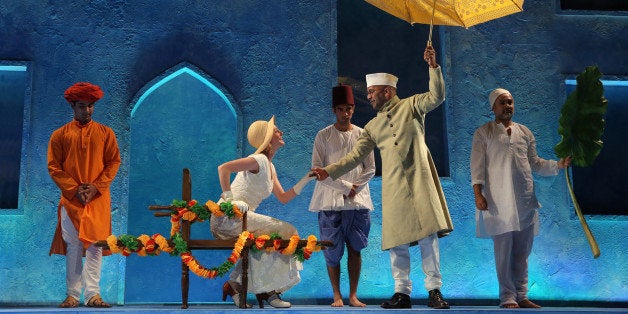
It is always a joy to spend a night at the theater with Tom Stoppard. You can count on sparkling and witty wordplay, a mystery or two to be solved, a history lesson complete with footnotes, challenging and stimulating debate, and usually a love story. In the case of Indian Ink, the love story is the playwright's with India.
In the excellent Roundabout Theater production of Indian Ink, it's first New York staging, there is also a first-rate cast of 15 led by Romola Garai and the estimable Rosemary Harris along with Firdous Bamji and Bhavesh Patel and smart and fluid direction from Carey Perloff that moves the story seamlessly between 1930 and the 1980's.
On the surface, the play is about a fictional free-spirited English poet named Flora Crewe who traveled to India in 1930 and an Indian artist named Nirad Das who painted her portrait. At its heart, however, is Stoppard's paean to India, where he lived for several years as a child.
Flora was something of a scandal back in the flapper era. Her verse, dismissed in her time, was openly about sex and she was famously painted in the nude by Modigliani. She had a passion for motor cars and went through men like batteries -- "when things went flat she would just put in a new one." She ostensibly has come to India to lecture on "Literary Life in London" but in fact she has come to die.
But as is so often the case with shifting and fickle literary tastes, Flora is now regarded as a lost poetic genius just a scant 50 years later. An American scholar, researching that final trip to India with an eye to writing her biography, has landed on the doorstep of Flora's younger sister, Eleanor, in London in the 1980's seeking access to the letters Flora wrote home.
The play shifts backward and forward in time, and touches on myriad topics that range from the love-hate relationship between India and Britain during the Raj and after, to the very nature of art, as embodied in the Indian concept of rasa, which as Das explains it, is the essence, or "juice," of any artistic endeavor, the emotion a work of art makes you feel. According to Das there are nine rasas and each has a different color.
Indian Ink -- the title refers to the poem Flora is writing during the course of the play -- opens with her arriving in Jammapur (now Jamalpur in Bangladesh) to lecture at the local Theosophical Society. She agrees to sit for Das, mingles with the Brit ex-pats, receives a marriage proposal from the Assistant Resident, and has an audience with the local Rajah, who shows off his collection of motor cars and gives her an erotic sketch.
The action leaps forward to the 1980's with Eleanor, who also lived in India for a time and is now 74 and a widow, serving tea at her home in London to Eldon Pike, the American professor. Stoppard can never resist a dig at academia, and after reading one of Flora's letters in which she says she had dreamt of "the Queens Elm," Pike smugly explains to Eleanor that's why his work is important.
"Which Queen?" Pike muses. "Which elm? Why would she dream about a tree? This is where I come in. To lighten the darkness."
"It's a pub in the Fulham Road," Eleanor drily explains.
During her sittings with Das, Flora and the artist exchange views on the Raj, art, and even sex. Flora is enraptured by the beauty of India, but is somewhat defensive of the Empire, at least at the outset; Das is a secret nationalist but an avid enthusiast of English literature. At one point he asks Flora where her sister lives in London.
"Eleanor lives in Doughty Street," Flora answers.
"But, Miss Crewe," Das, whose knowledge of London geography rivals the A to Z, gushes. "Charles Dickens lived in Doughty Street. Oliver Twist was written in that very street."
The final pieces of the puzzle that surrounds Flora's time in India and her relationship with Das begin to fall in place when Eleanor gets a visit from Das's son, Anish, also a painter but now living in London himself with an English wife. Even half a century later the passions over the Raj can flare. In the course of conversation Anish mentions that his family had been loyalists up to India's first war of independence.
"What war was that?" Eleanor asks, confused.
"The Rising of 1857," Anish replies.
"Oh, you mean the Mutiny," she bridles. "What did you call it?"
Garai, perhaps best-known here for her work in the movie "Atonement" and the British TV series "The Hour" and "Emma," astutely underplays the role of Flora, creating a spunky yet vulnerable and all too human woman who belies the scandalous stories that accompany her like baggage, a feminist ahead of her time, but a friendly and kindly one.
Harris is pitch-perfect as Eleanor, somewhat bemused but pleased by the attention her sister is attracting after all this time. And her own love of India is palpable, as when she wistfully recalls for Das junior how she loved the fruit trees "at home" -- the "orchards of apricot, almond, plum." Harris conjures their beauty so you can see them and smell them.
Bamji delivers a nuanced performance as Nirad Das, using small personal habits such as pulling at his eyebrow or using his scarf to cover his mouth to create a reticent artist unsure of his talents or place in the world. And Patel gives a fine reading of Anish Das, a polite yet self-confident Indian living comfortably and at ease in London in the mid-1980's and unafraid to speak his mind.